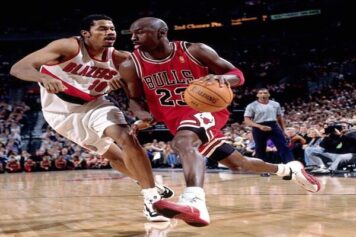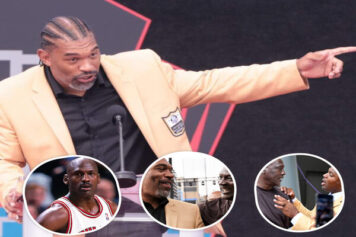How do you define greatness? Is it based on what people tell you or do you know it when you see it?
Is it in a single event or play? Is it performed by an individual?
Tom Brady orchestrating a game winning drive. Steph Curry with the shot. A brilliant dribbling display by Messi. A Kershaw or King Felix no-hitter. A Ronda Rousey armbar.
Is it defined in the number of championship victories or is it going undefeated in a season or for a career? Is it dependent upon their demeanor outside of the playing arena?
What is greatness?
Many believe Michael Jordan was the greatest basketball player of all time. They saw him play. They saw the championships. They saw the determination, desire and will to win. They didn’t see the greatness of others, names like Wilt, Russell or the Big “O.” Different eras. Different athletes. Different competition. In this sense, greatness can be defined by witnessing. But just because a tree falls in the forest and no one was around to hear it….
Debating sports is always a matter of opinion and philosophy. If it wasn’t seen, can it be debated fairly? Regardless of the sport, the “GOAT” debate will always erupt and exist. But no matter the sport, there is one definition of greatness that immediately comes to mind when “The Greatest” is mentioned.
Ali.
Self-proclaimed anointing of the highest order, Cassius Clay had not yet achieved elite status when he voiced those words. Boastful and unapologetic, he defeated Sonny Liston and became heavyweight champion of the world. But, even for Ali, GOAT status is achieved over time, not in a single moment.
Converting to Islam shortly after the Liston fight, Cassius Clay became Muhammad Ali. The Black Superman was a man’s fighter. Strong, fast and an ego the size of 10 Madison Square Gardens. He feared no one, opponent or the government and he fought all of the greats: Frazier, Foreman, Spinks, Patterson, Norton winning all but five matches in his illustrious career.
But Ali’s impact was felt beyond the boxing ring. He lived in a time of racial upheaval and demand for civil and equal rightst. A bold, brash black man didn’t sit well with white America. Like Nas, all he needed was one mic and it was on. Ali was, and still is, a hero to millions across the globe and is recognized by some as the most important athlete in history.
Many would argue that Ali was the greatest, but only when it comes to boxing. To these fans, and those involved in creating ESPN’s “SportsCentury,” the greatest athlete in history had two letters.
MJ.
Six NBA championships. 14-time All-Star. 5-time NBA MVP. 6-time NBA Finals MVP. Multiple player of the year awards in college. Record holder in multiple NBA categories. The first NBA player to have his OWN sneaker deal with the League.
#23, Michael Jordan.
His fierce desire to win intimidated opponents and excited fans. He had an insatiable desire to be victorious and to be the best. Almost was never good enough in Jordan’s mind. He pushed and pushed until he got the result he wanted and he demanded the same from teammates.
Underneath that winner-take-all mentality, however, was something that burned deep inside of Jordan. Every perceived slight, every snub, every insult built on top of the other. Brewing. Festering. There is no statute of limitations inside the memory of Jordan. It fueled him and drove him to work harder than everyone else. Quit wasn’t part of the Jordan vocabulary. Tell him he couldn’t do something and he’d prove you wrong. Ask Portland if he can shoot the three. Ask Utah fans about him picking on someone his own size. When the game was on the line, the ball was in the hands of Jordan; ask Cavs fans about what came next. Even when everyone in the arena knew what was coming, Jordan still had a way of providing the spectacular.
Today’s players like Kobe Bryant and LeBron James are measured against two letters. From scoring titles to championship rings to television ratings, Jordan is their measuring stick.
Like Ali, Jordan’s impact was felt beyond the basketball court, especially when it came to business. Never had the world seen a man, a black man at that, rise to the heights in sports business quite like Michael Jordan. The Air Jordans from Nike became more than a shoe; they became a status symbol. “Be like Mike” became a slogan everyone began singing and aspiring to.
As he was embarking upon winning his fifth Finals title, another single name had emerged by donning a green jacket, a name that would re-define the sport of golf and inspire a new legion of golfers.
Tiger.
He won the 1997 Masters in a record-breaking performance, drawing attention from new audiences to a sport that was reserved for the privileged. For a time, Tiger Woods was discussed in the same breath as Jordan and Ali. He dominated majors and tournaments. He changed the game of golf for the better.
From the time of his appearance at age 2 on The Mike Douglas Show to 2008 when he won his last major championship, Tiger was on track to be the greatest golfer of all time.
Then Thanksgiving 2009 happened. Derailment happened. The personal life of Tiger Woods was exposed for all the world to see. Not a pretty sight for the future G.O.A.T in golf. Instead, he became something else. Something we didn’t want to see; a shell of himself.
Like Jack Nicklaus and others before him, Tiger changed the sport. He was strong, powerful, athletic – a record-setter and barrier-breaker. There was no course, no score, no tournament that could hold him back. Not even the prestigious Augusta National could stop Tiger from conquering it.
His mixed ethnicity appealed to many. African-American, Asian, Caucasian he was winning in a sport that various groups claimed him as their own, for good reason. Before 2009, what was not to like about Eldrick Tiger Woods?
He was golf’s golden ticket. When Tiger played a tournament, or was in contention to win, ratings soared and ad prices jumped. The question (or joke) became, Who you got: Tiger or the field? Men, boys wanted to play golf like Tiger. In his 2009 season, Tiger was ranked in every single measurable category in golf, usually in the top 10. But as his personal life spiraled downward and the physical ailments trended upward, those same category rankings suffered.
Now the running (joke) question is, will he ever win another major?
Has time passed Tiger by? That question remains unanswered for now. Golfers can play and win majors well beyond their prime but what seems to have passed him by is the opportunity to be the greatest. Woods is four majors from Jack Nicklaus’ record of 18. Not one four! Until he gets closer to Nicklaus, he’s no longer in the Ali-Jordan conversation.
So who was next? Who would be the next athlete to enter the GOAT conversation? The answer to that question has come to us straight outta Compton in the form of six letters.
Serena.
Serena Williams is 33 years old, 34 on September 26 and still going strong. Winner of 21 Grand Slam singles titles (more than any other active player, male or female). Owner of a career Grand Slam and two Serena Slams (four majors in a row).
Singles, doubles, Olympic titles Serena Williams has done just about all there is to do in tennis.
While it is always difficult to compare players from different eras, there can be no doubt of the improved athleticism of today’s players. Bigger, faster, stronger in all areas, that’s the type of competition Williams has faced during her career.
I’d put her in the same pantheon of a Michael Jordan, said John McEnroe before Tuesday’s Venus-Serena match. Win or lose, Serena was the greatest according to McEnroe.
On Friday, September 11, 2015 Serena was three sets from history. Up a set in her U.S. Open women’s semi-final match against Italy’s Roberta Vinci, she was nearing a calendar year Grand Slam. Despite what Serena says, her play tightened up. Repeated unforced errors came off of Serena’s racket. Every time she thought she had a winner, Vinci would respond, forcing Serena into a volley.
The pressure Serena puts on herself is immense. I love to win and that’s no secret, said Serena before her Tuesday match with Venus. To win under the weight of a potential calendar year Grand Slam, 22 Grand Slam titles to tie Steffi Graf and the eyes of the sports and social media worlds watching that’s pressure unparalleled by this or any generation prior. Every move she made, word she spoke, picture she appeared in and article written about her was dissected and analyzed.
Serena is known as one of the most mentally tough players in sports, not just tennis. Like golf, it requires unique skill and mental discipline. It’s you versus yourself and you versus your opponent. During Friday’s semi-final, it was Serena versus self and then Serena versus Roberta Vinci. The first battle was a struggle from the get-go despite her first set win. She did not appear to be at the top of her game; her skills and athleticism won that set.
As we watched the final two sets play out, those who have seen her, have watched Serena from the beginning not of 2015, but since she came on the scene we didn’t want to admit it, but we knew. She wasn’t playing like the Serena we’ve come to appreciate as an athlete. She’d been able to laugh in the face of adversity many times over. But footwork, reaction time, body language and her serve, that glorious serve, were fading like the smile on her face.
Credit goes to Roberta Vinci for adding to that pressure with shot after shot, slice backhand after slice backhand. Vinci played without thinking, freely, forcing Serena to think about each return shot perhaps a bit too much. Every shot brought hope. Every missed shot brough angst. History was slipping away, but still, still, still the people cheered loudly, or inside, that the infamous COME ON would drive her to victory yet again.
Vinci responded with a resounding “no” in the form of 2-6, 6-4, 6-4. History’s serve was broken.
So proud of you, @SerenaWilliams. What you did this year was amazing. -mo #USOpen2015
The First Lady (@FLOTUS) September 11, 2015
With this loss, where does this leave Serena? Before the U.S. Open, there was talk of her being the greatest of all time (G.O.A.T.). Does the lack of a calendar year Grand Slam, the greatest achievement in tennis, diminish her greatness?
Serena still owns 21 titles with the potential of more in 2016. At age 34, will she still have the desire and fire to win? Given Serena’s competitiveness, it is hard to count her out to win, at the very least, one more Grand Slam tournament. Another Olympic gold or two could be possible next year in Rio.
Regardless of her U.S. Open performance, 2015 was the year of Serena. Like Ali, MJ and Tiger, all types of people and fans tuned in to watch this American champion’s march to greatness. The four other major events all saw increases in ratings for their women’s finals this year; a trend that reflected years prior when Serena played and according to the Washington Post, the Williams sisters’ U.S. Open duel on September 8th drew college football-like ratings (4.8 rating with a 5.6 peak).
When Serena played, tennis and non-tennis fans tuned in. They tuned in for history. They tuned in for greatness. They tuned in for Serena. She inspired them.
Some may discount her greatness because of past behavior. It could be argued, however, she shares similar traits with the greats in other sports. Ali, Jordan they were driven. Driven to win. Disrespecting opponents or decking a teammate it was all about winning for them. Ali and Jordan had their losses. They stayed in their sport a bit too long. But that doesn’t diminish their greatness and neither should it for Serena. No double-standards here.
Tiger was great for a time, but he is 39. Close to 34, Serena is still dominant. It’s hard to imagine her faltering any time soon. One more major win and she will tie Steffi Graf for second in single Grand Slam tournament titles. That’s two behind American Margaret Court’s 24, which she did in the 1930’s when the competition and playing surfaces were far different than today.
But if she never wins another, will she be in the same pantheon as Jordan? Will she be bestowed with GOAT status?
How do you define a GOAT? Stand undefeated like Floyd Mayweather, who defeated Andre Berto Saturday night for his 49th win? Is it longevity – Roger Federer has the most Grand Slam singles titles for men at 17, but he’s never achieved a calendar year Grand Slam; is he the greatest?
GOAT or not, Serena brought greatness to tennis in 2015. She brought greatness to women’s sports beyond anything the USA women’s soccer team did in their World Cup run. It was Serena, alone, on the court, under the spotlight fighting against herself and her opponent. No teammates to carry her during the match when she had an off day. No teammates to take over the media spotlight so she could focus on the task at hand.
It was just Serena.
Like Ali, Jordan and Tiger before her, she has become the standard by which all are judged against in tennis. As commentator and former player Mary Jo Fernandez said post-match today, Serena transcends our sport. Her near-historic run went beyond race and gender. And despite the hate, she still won. Until Friday.
But that happens to the best of them, even to the greats.
Even to a GOAT, no matter which way you define it.



